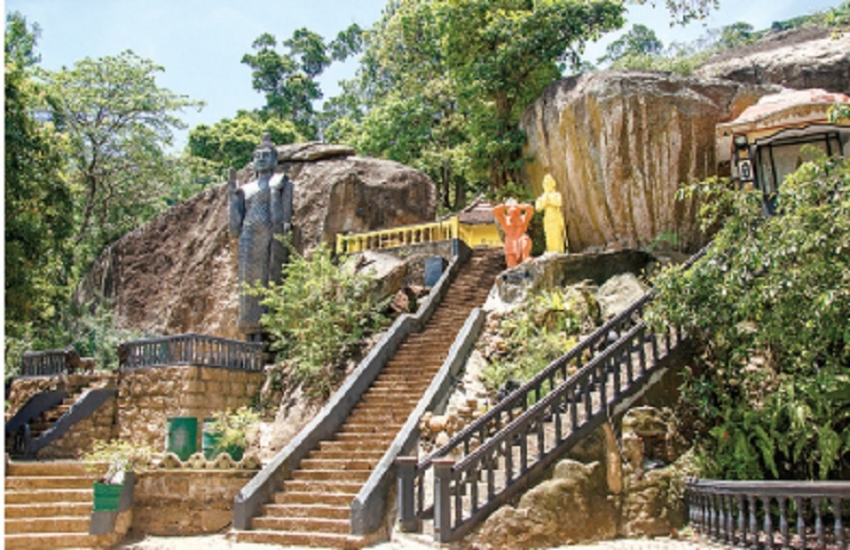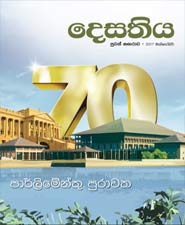The setting is surreal – cloud-kissed hills, a landscape abundant in greenery in Pallebedda near Embilipitiya.The luxuriant vegetation of Ratnapura slowly disappears giving way to the aridity of the Southern Province. Across the hills, a soft breeze blows through the forest canopy and keeps us mesmerized. We drove down drinking in the beauty of nature further toward Embilipitiya and spotted a white dagoba in the distance lying in a tranquil setting on a rocky mountain amidst forest patches on its left. A name board read, ‘Sri Sankapala Purana Raja Maha Viharaya’ the arched granite entrance telling us the way to the temple situated at the foot of the mountain. This historic cave temple is located 9.5 km beyond the Pellebedde town, abutting the Pelmadulla – Embilipitiya main highway.
Although many of us are unaware of this site, it is a unique ancient shrine, the historical and picturesque importance of which is second only to Ath Vehera at Mihintale and Situlpahuwa in the Yala Sanctuary.
Legend has it that Pussadeva, one of the ten warriors of King Dutugemunu’s Army had performed a significant role to unite the country defeating the South Indian Chola invaders. He was well versed in the art of war, a good archer and could wield the bow and arrow with great skill. A great warrior, Pussadeva was known for his prowess in blowing the conch shell and his duty was to herald battles and victories of Prince Gemunu. Hence, the emblem of the conch shell was used to identify him. The motif of the conch is engraved in the rock 20ft. above the cave under a drip-ledge which is still visible. It derived the name Sankapala – Sanka means conch and Pala–the administrator, refers to the conch blower in the King’s Army. Eventually, he meditated and became an arahat and passed away in this hallowed sacred place, considered as a reputed Buddhist monastery for monastic bhikkus.
The Sankapala cave complex and the Pallebedda village are said to have been given to the great warrior, Pussadeva. It is evident by an inscription in the cave complex referring to Pussadeva and a symbol of a conch which has given rise to the name ‘Sankapala’ to this cave temple. Brahamin inscriptions carved beneath the drip-ledge caves date back to the period of King Dutugemunu.
The rocky mountain is dotted with caves in the slope amid the forest canopy, an ideal setting for secluded monastic bhikkus who lived there. A cluster of cave shrines, dagobas, stone pillars and a rock-cut flight of steps erected on the rocky platform depict a picturesque view of green carpet from the distance.
The Sankapala cave temple and monastic complex flourished in the Polonnaruwa period until the great famine, which forced the Bhikkus to flee to other areas. The cave temple then fell into disuse becoming part of the jungle.
The rock-cave shrine had its origin in the pre-Christian era. In 1786, King Rajadhi Rajasingha had made an offering of this temple together with a land grant of 13,000 acres to Ven. Karatota Dhammarama Thera in appreciation of his unique poetic competition popularly known as ‘Barasakavya’, in which one verse could be read as 12 verses by a symmetric arrangement of letters. Being imprisoned by the King under suspicion of having liaisons with the enemy, the Dutch, Ven. Dhammarama wrote this poem during his incarceration. It was such an excellent work that the King, himself a poet, was impressed enough to release the monk.
As many as 14 natural rock caves with drip ledges are scattered in the surrounding areas of Sankapala. Three of them contain Brahmin inscriptions. Ancient statues of the Buddha belonging to the Kandyan period are housed in a natural cave turned into shrine rooms with beautiful scenic settings of the cave temple making it a spiritual place. At a higher elevation is a small, but beautiful white brick built dagoba erected on a rocky surface which had been in a ruined condition until 1942, and eventually renovated. It looks beautiful amidst the forested hill. From the base of the dagoba we sighted the Rakwana and Suriyakanda mountain range projecting a panoramic view at a distance.
King Dutugemunu gave Pussadeva 13,000 acres of land in Pallebedde in recognition of the warrior’s service to the country. Later on, the warrior, donated all the lands to Buddhist bhikkus, and he took to the robes. It is said that all the valuables he possessed, among them the conch he blew to herald battles, are today hidden within a rock above the hill. Eventually, Pussadeva had entered the order of bhikku and attained arahathood at this hallowed temple ground. Bhikku Pussadeva, as he was called, was so distraught by the memories of a youth spent in battle and bloodshed that he found it easy to perceive the Dhamma. He meditated and became an arahath at Sankapala, attaining the supreme bliss of Nirvana and ending the cycle of rebirth.
Driving around 1.5 km on the main road toward Pallebedde we came across the ruins of a small brick dagoba in a corner on a two acre rock boulder overlooking the forested hills. It is said that Arahat Pussadeva was cremated here and his remains enshrined in the brick monument on top of the rocky boulder. Most visitors to Sankapala are unaware of this and miss this site. They are mainly pilgrims on their way to the shrine of Kataragama via Nonagama or Thanamalvila.
The spacious car park is always filled with bus loads of pilgrims. The villagers sell souvenirs to pilgrims alongside the road that leads to the cave temple. On Full Moon Poson Poya, hundreds of farming community throng this sacred shrine, travelling in hand-tractors with their entire families in surrounding villages, which is a sight to be behold.
The visitors can view the statues of Buddha, King Dutugemunu, the giant Pussadeva and Ven. Karatota Dhammarama, flanked by the neatly constructed flight of steps on either side of the temple ground.
The rocky boulder of the sprawling cave temple comes alive with vibrant Buddhist sculptures in various places of the rocky mountain.
The two massive statues of Buddha reclining and standing, are seen amidst rocky caves.
Perhaps, more treasures of this historic place still remain underground waiting to be dug up. If an extensive excavation is carried out here, more inscriptions, ancient artifacts and the lost glory of Sankapala could surely be unearthed.
The setting is surreal – cloud-kissed hills, a landscape abundant in greenery in Pallebedda near Embilipitiya.The luxuriant vegetation of Ratnapura slowly disappears giving way to the aridity of the Southern Province. Across the hills, a soft breeze blows through the forest canopy and keeps us mesmerized. We drove down drinking in the beauty of nature further toward Embilipitiya and spotted a white dagoba in the distance lying in a tranquil setting on a rocky mountain amidst forest patches on its left. A name board read, ‘Sri Sankapala Purana Raja Maha Viharaya’ the arched granite entrance telling us the way to the temple situated at the foot of the mountain. This historic cave temple is located 9.5 km beyond the Pellebedde town, abutting the Pelmadulla – Embilipitiya main highway.
Although many of us are unaware of this site, it is a unique ancient shrine, the historical and picturesque importance of which is second only to Ath Vehera at Mihintale and Situlpahuwa in the Yala Sanctuary.
Legend has it that Pussadeva, one of the ten warriors of King Dutugemunu’s Army had performed a significant role to unite the country defeating the South Indian Chola invaders. He was well versed in the art of war, a good archer and could wield the bow and arrow with great skill. A great warrior, Pussadeva was known for his prowess in blowing the conch shell and his duty was to herald battles and victories of Prince Gemunu. Hence, the emblem of the conch shell was used to identify him. The motif of the conch is engraved in the rock 20ft. above the cave under a drip-ledge which is still visible. It derived the name Sankapala – Sanka means conch and Pala–the administrator, refers to the conch blower in the King’s Army. Eventually, he meditated and became an arahat and passed away in this hallowed sacred place, considered as a reputed Buddhist monastery for monastic bhikkus.
The Sankapala cave complex and the Pallebedda village are said to have been given to the great warrior, Pussadeva. It is evident by an inscription in the cave complex referring to Pussadeva and a symbol of a conch which has given rise to the name ‘Sankapala’ to this cave temple. Brahamin inscriptions carved beneath the drip-ledge caves date back to the period of King Dutugemunu.
The rocky mountain is dotted with caves in the slope amid the forest canopy, an ideal setting for secluded monastic bhikkus who lived there. A cluster of cave shrines, dagobas, stone pillars and a rock-cut flight of steps erected on the rocky platform depict a picturesque view of green carpet from the distance.
The Sankapala cave temple and monastic complex flourished in the Polonnaruwa period until the great famine, which forced the Bhikkus to flee to other areas. The cave temple then fell into disuse becoming part of the jungle.
The rock-cave shrine had its origin in the pre-Christian era. In 1786, King Rajadhi Rajasingha had made an offering of this temple together with a land grant of 13,000 acres to Ven. Karatota Dhammarama Thera in appreciation of his unique poetic competition popularly known as ‘Barasakavya’, in which one verse could be read as 12 verses by a symmetric arrangement of letters. Being imprisoned by the King under suspicion of having liaisons with the enemy, the Dutch, Ven. Dhammarama wrote this poem during his incarceration. It was such an excellent work that the King, himself a poet, was impressed enough to release the monk.
As many as 14 natural rock caves with drip ledges are scattered in the surrounding areas of Sankapala. Three of them contain Brahmin inscriptions. Ancient statues of the Buddha belonging to the Kandyan period are housed in a natural cave turned into shrine rooms with beautiful scenic settings of the cave temple making it a spiritual place. At a higher elevation is a small, but beautiful white brick built dagoba erected on a rocky surface which had been in a ruined condition until 1942, and eventually renovated. It looks beautiful amidst the forested hill. From the base of the dagoba we sighted the Rakwana and Suriyakanda mountain range projecting a panoramic view at a distance.
King Dutugemunu gave Pussadeva 13,000 acres of land in Pallebedde in recognition of the warrior’s service to the country. Later on, the warrior, donated all the lands to Buddhist bhikkus, and he took to the robes. It is said that all the valuables he possessed, among them the conch he blew to herald battles, are today hidden within a rock above the hill. Eventually, Pussadeva had entered the order of bhikku and attained arahathood at this hallowed temple ground. Bhikku Pussadeva, as he was called, was so distraught by the memories of a youth spent in battle and bloodshed that he found it easy to perceive the Dhamma. He meditated and became an arahath at Sankapala, attaining the supreme bliss of Nirvana and ending the cycle of rebirth.
Driving around 1.5 km on the main road toward Pallebedde we came across the ruins of a small brick dagoba in a corner on a two acre rock boulder overlooking the forested hills. It is said that Arahat Pussadeva was cremated here and his remains enshrined in the brick monument on top of the rocky boulder. Most visitors to Sankapala are unaware of this and miss this site. They are mainly pilgrims on their way to the shrine of Kataragama via Nonagama or Thanamalvila.
The spacious car park is always filled with bus loads of pilgrims. The villagers sell souvenirs to pilgrims alongside the road that leads to the cave temple. On Full Moon Poson Poya, hundreds of farming community throng this sacred shrine, travelling in hand-tractors with their entire families in surrounding villages, which is a sight to be behold.
The visitors can view the statues of Buddha, King Dutugemunu, the giant Pussadeva and Ven. Karatota Dhammarama, flanked by the neatly constructed flight of steps on either side of the temple ground.
The rocky boulder of the sprawling cave temple comes alive with vibrant Buddhist sculptures in various places of the rocky mountain.
The two massive statues of Buddha reclining and standing, are seen amidst rocky caves.
Perhaps, more treasures of this historic place still remain underground waiting to be dug up. If an extensive excavation is carried out here, more inscriptions, ancient artifacts and the lost glory of Sankapala could surely be unearthed.







